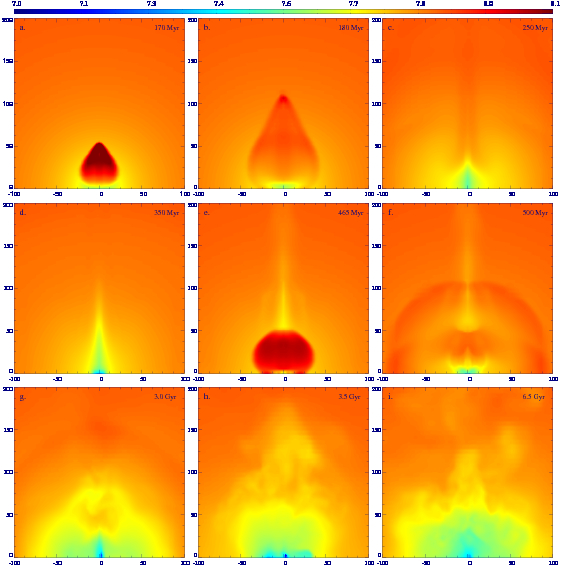
Feedback da buchi neri negli ammassi di galassie
I buchi neri supermassivi (miliardi di masse solari) al centro dei più grandi sistemi cosmologici collassati, quali i gruppi e gli ammassi di galassie, non solo risucchiano gradissime quantità di materia circostante, ma al contempo proiettano getti di gas rovente (centinaia di milioni di gradi) a distanze di decine di migliaia di anni luce. Tali nulcei galattici attivi (AGN) sono fondamentali per l'evoluzione delle galassie: essi fungono infatti da "termostati", inibendo in maniera regolata il raffreddamento del gas e in definitiva la formazione di nuove stelle. Grazie a potenti supercomputer e ad avanzati codici numerici, in grado di seguire la dinamica del gas su scale del buco nero fino a milioni di anni luce di distanza, abbiamo trovato dei modelli teorici che concordano con le più recenti osservazioni. Questi modelli dimostrano come il gas espulso dal nucleo galattico attivo riesca a comunicare energia al tenue gas che permea l'ammasso, situato a milioni di anni luce dal buco nero.
Riferimenti bibliografici:
"The dance of heating and cooling in galaxy clusters: 3D
simulations of self-regulated AGN outflows"
Autori: M. Gaspari (massimo.gaspari4@unibo.it), C. Melioli, F. Brighenti and A. D'Ercole
Giornale: Monthly Notices of the Royal Astronomical Society (2010)
doi:10.1111/j.1365-2966.2010.17688.x
Fig. a sinistra: mappa osservata del Ferro (integrata lungo la linea di vista), in tre fasi evolutive differenti.

Black hole feedback in galaxy clusters
Supermassive black holes (billions of solar masses) at the center of the largest collapsed cosmological systems, such as galaxy groups and clusters, not only "eat" huge amount of the surrounding material, but also generate very powerful jets of hot gas (hundreds of millions of degrees) which propagate to distance of thousands of light years. This active glactic nuclei (AGN) are key for the evolution of galaxies: they act indeed as "thermostats", quenching the gas cooling and the star formation in a self-regulated way. Using advanced 3D numerical codes and supercomputers, we have studied the dynamics of the gas from black hole scale up to millions of light years away. Our models explain how the jet ejected by the AGN transfers energy to the tenuous gas which permeate the galaxy cluster. This energy exchange prevents the gas from cooling to very low temperatures and form new stars.
References:
"The dance of heating and cooling in galaxy clusters: 3D
simulations of self-regulated AGN outflows"
Authors: M. Gaspari (massimo.gaspari4@unibo.it), C. Melioli, F. Brighenti and A. D'Ercole
Journal: Monthly Notices of the Royal Astronomical Society (2010)
doi:10.1111/j.1365-2966.2010.17688.x
Fig. on the left: observed Iron map (integrated along line of sight), at three different phases of the evolution.
Filmato: interazione getto - gas intergalattico
Nel seguente filmato presentiamo l'evoluzione, lunga 500 milioni di anni, di un getto generato dal buco nero al centro di un ammasso di galassie (migliaia). I quattro pannelli mostrano, partendo da in alto a sinistra: una fetta ridotta della densità (n, in logaritmo), passante per il centro del "cubo" di gas simulato (milioni di anni luce); una fetta della velocità totale (v); una fetta della temperatura (T); ed infine come varia la densità e la temperatura in funzione della distanza dal buco nero, ovvero r. Le frecce sovrapposte alle mappe rappresentano la velocità e direzione di movimento del gas. Il filmato mostra due diversi eventi di getto, il secondo molto più potente del primo: non appena il gas inizia a raffreddare e quindi a cadere verso il buco nero, quest'ultimo reagisce generando un getto molto caldo e veloce (migliaia di km/s), il quale spazza via e riscalda il gas soprastante. Il secondo getto mostra inoltre la creazione di una tipica "bolla" nell'ambiente, che a sua volta si espande e riscalda il gas in ogni direzione. Questo tipico ciclo si ripeterà più volte nel corso della storia dell'universo (diversi miliardi di anni), impedendo ogni volta la sovraproduzione di gas freddo e quindi di stelle.
Se vuoi scaricare il filmato, clicca QUI col tasto destro e procedi con Salva...(NB: il file è grande 32 MB; la risoluzione è più elevata)
Movie: interaction jet - intergalactic medium
In the following movie, we show the evolution (500 millions yr) of a jet generated by the the black hole at the center of a galaxy cluster (thousands). The four panels, starting from the top left corner: density slice through the center of the simulated gas "cube" (n, in logarithm); total velocity slice (v); temperature slice (T); and one dimensional plots of density and temperature in function of the distance from the black hole (i.e. r). The arrows superimposed to the maps represent the velocity and direction of gas motion. The movie shows two different types of jet events, the second one much more powerful: as soon as the gas starts to cool and thus to fall inward toward the black hole, the latter generates a very hot and fast jet (thousands of km/s). This outflow sweeps away and heats the surrounding gas. The second jet further depicts the typical creation of a "bubble" in the ambient medium, which heats again the gas through its buoyant motion. This common cycle will repeat several times during the evolution of the universe (many billions of years), halting every time the overcooling and in the end the formation of stars.
If you want to download the movie file, right click HERE and proceed with Save as...(Note: the file is large 32 MB; higher resolution)